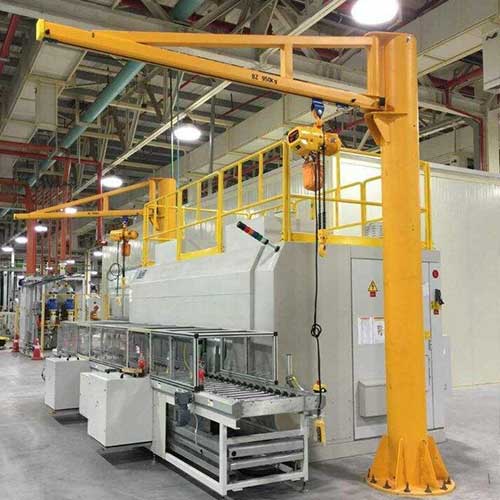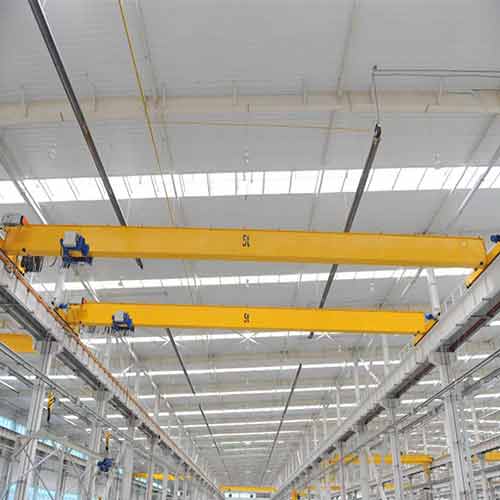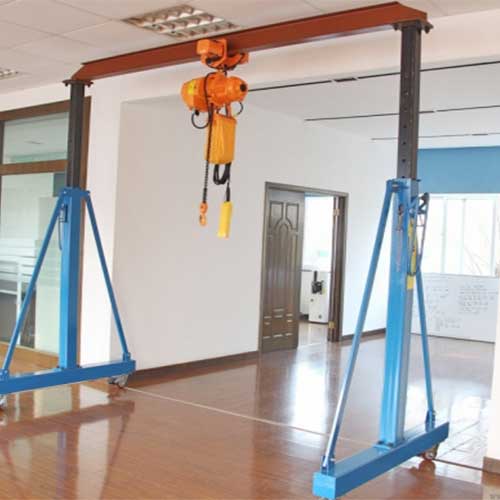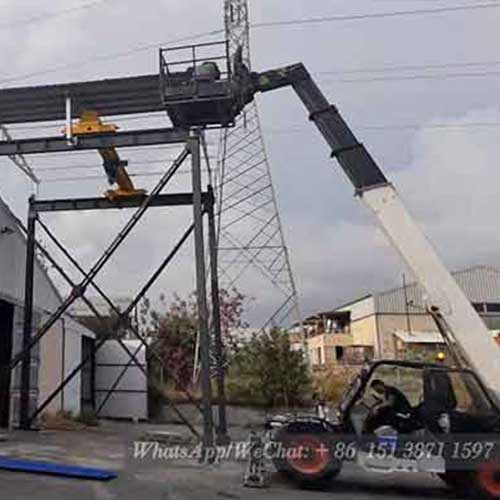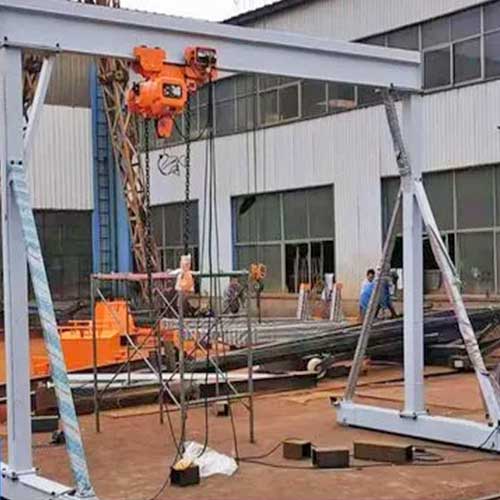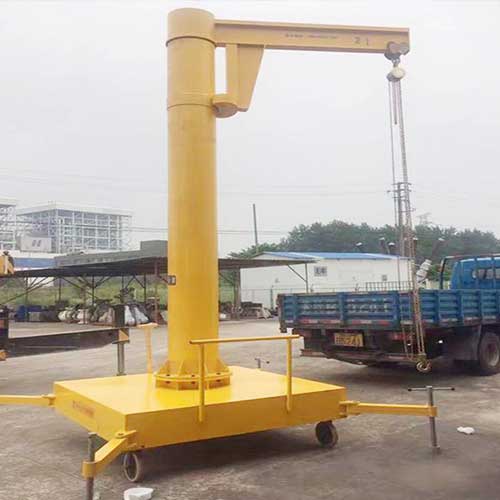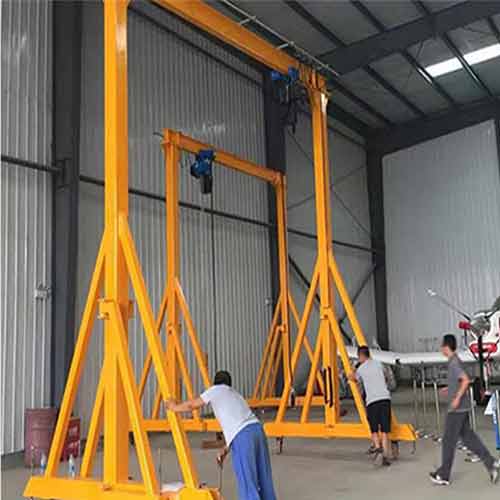Your Trusted Small Overhead Crane Manufacturer & Supplier
Small Cranes for Sale, 1 Ton, 2 Ton, 3 Ton, Small Cranes Types, Uses & Selections
Small Size, Light Weight, High Protability, Ease Use, Cheap Small & Mini Crane for You
Small cranes play a crucial role in enhancing both operational efficiency and safety in the workplace. Their compact size enables them to fit into tight areas where larger cranes cannot operate, such as small workshops, garages, and tight manufacturing lines. By providing targeted lifting capabilities, small cranes help streamline workflows, reduce downtime, and allow for quicker job completion.
Moreover, safety is a primary concern in any lifting operation. Small cranes are designed with features that minimize risks, such as overload protection and stable bases. Their ease of use ensures that operators can lift and move loads with confidence, reducing the likelihood of accidents. The ability to handle lighter loads safely not only protects workers but also reduces the risk of damage to materials and equipment.
Defining Features of Small Cranes
Several key characteristics define small cranes, making them suitable for a variety of applications:
- Size: Small cranes are designed to fit into confined spaces, making them ideal for environments where height and width are restricted. Their compact dimensions allow for installation in areas that traditional cranes cannot reach.
- Capacity: These cranes typically handle lighter loads, making them suitable for tasks that do not require heavy-duty equipment. Their lifting capacities often range from a few hundred kilograms to several tons, making them perfect for everyday lifting needs.
- Portability: Many small cranes are portable, allowing for easy relocation between job sites. This feature is especially valuable for businesses that require flexibility in their lifting operations, enabling quick adjustments based on project demands.
- Ease of Use: Small cranes are designed for straightforward operation, often featuring manual or simplified electric controls. This user-friendly design ensures that operators can quickly learn to use the equipment effectively, enhancing productivity and minimizing the learning curve.
In summary, small cranes are becoming increasingly vital in various industries due to their growing demand, ability to enhance efficiency and safety, and their defining features that cater to specific operational needs. By understanding the significance of small cranes, businesses can make informed choices that improve their lifting capabilities and overall productivity.
Defining Features of Small Cranes
Size
Small cranes are engineered with compact dimensions to fit into confined spaces, making them ideal for environments with height and width restrictions.
- Compact Design: The physical size allows for installation in locations that traditional cranes cannot access, such as narrow aisles in warehouses, workshops, or garages.
- Space Optimization: By utilizing small cranes, businesses can maximize usable floor space, facilitating better workflow and operational efficiency.
- Versatile Applications: Their size makes them suitable for a variety of applications, including assembly lines, automotive repair shops, and light manufacturing facilities.
Capacity
Small cranes are primarily designed to handle lighter loads, which makes them suitable for a range of everyday tasks without the need for heavy-duty equipment.
- Weight Range: Typically, these cranes can lift loads ranging from a few hundred kilograms to several tons, addressing the needs of light lifting applications.
- Ideal for Routine Tasks: Perfect for moving tools, materials, or light machinery, they can streamline operations in environments where heavy lifting is not necessary.
- Cost-Effective Solutions: Smaller lifting capacities reduce the investment needed compared to industrial-grade cranes, making them an economical choice for businesses with lighter lifting requirements.
Portability
Many small cranes feature portability, allowing for easy movement between job sites, which is crucial for businesses that require flexibility in their operations.
- Easy Relocation: Portable cranes can be quickly moved and set up in various locations, reducing downtime and increasing efficiency during project changes.
- Adaptable Use: Ideal for temporary job sites or fluctuating project demands, portable cranes can adapt to different environments without extensive setup time.
- Mobility Options: Models are available with wheels or casters for added convenience, allowing operators to reposition the crane effortlessly as needed.
Ease of Use
Small cranes are designed for user-friendly operation, often featuring manual or simplified electric controls, which enhances their accessibility.
- Simplified Controls: Many models come equipped with intuitive control systems, ensuring that operators can learn to use the equipment quickly.
- Reduced Training Time: The straightforward operation minimizes the need for extensive training, allowing staff to become proficient without lengthy learning curves.
- Safety Features: Many small cranes incorporate safety mechanisms, such as emergency stop buttons and overload protection, to enhance operational safety.
In summary, small cranes offer numerous advantages that make them increasingly vital in various industries. Their compact size, light lifting capacity, portability, and ease of use contribute to improved efficiency and productivity. By selecting the right small crane, businesses can optimize their lifting capabilities and adapt more effectively to their specific operational needs.
Types of Small Cranes for Sale and Their Distinct Features
Small cranes have become indispensable tools across various industries due to their versatility, compact design, and ability to operate in confined spaces. Whether for lifting light loads in workshops, facilitating construction tasks, or streamlining manufacturing processes, the right small crane can significantly enhance efficiency and productivity. This section explores the diverse types of small cranes available for sale, highlighting their distinct features and applications. From portable gantry cranes that can easily be relocated to wall-mounted jib cranes designed for tight spaces, each type serves a unique purpose and meets specific operational needs. Understanding these various options enables businesses and individuals to select the most suitable crane for their lifting requirements, ensuring optimal performance and safety in their operations.
Small Gantry Cranes for Sale : Solutions for Flexible Lifting
Small gantry cranes are versatile lifting solutions designed to provide flexibility and efficiency in various applications. Their adaptability makes them suitable for both indoor and outdoor settings, catering to a range of lifting needs.
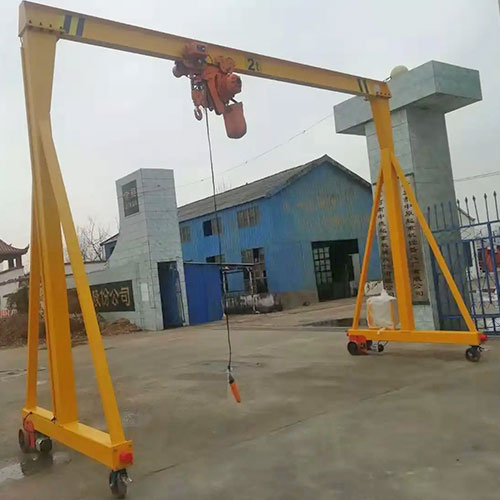
Small Portable and Mobile Gantry Cranes on Wheels
Portable and mobile gantry cranes are engineered for easy relocation, enhancing operational flexibility in temporary job sites.
Enhancing Flexibility and Efficiency in Temporary Job Sites:
- Quick Setup and Breakdown: These cranes can be assembled and disassembled rapidly, making them ideal for projects that require frequent repositioning.
- Maneuverability: Equipped with wheels or casters, portable gantry cranes can be easily moved across different locations, allowing for quick adjustments based on project demands.
- Ideal for Construction and Maintenance: Their portability makes them suitable for both construction sites and maintenance tasks, providing an efficient lifting solution wherever needed.

Mini Gantry Cranes for Compact Operations
Mini gantry cranes are designed specifically for applications where space is limited, yet precise lifting is required.
Popularity in Light-Duty Lifting and Assembly Tasks:
- Space-Saving Design: Their compact size allows them to fit into narrow aisles or small workshops, making them perfect for light-duty lifting tasks.
- Versatile Applications: Frequently used in automotive repair, small-scale manufacturing, and DIY projects, mini gantry cranes provide practical lifting solutions for handling light materials and components.
- Load Capacity: Typically capable of lifting loads of up to 1 ton, these cranes are well-suited for everyday tasks without the need for heavy-duty equipment.
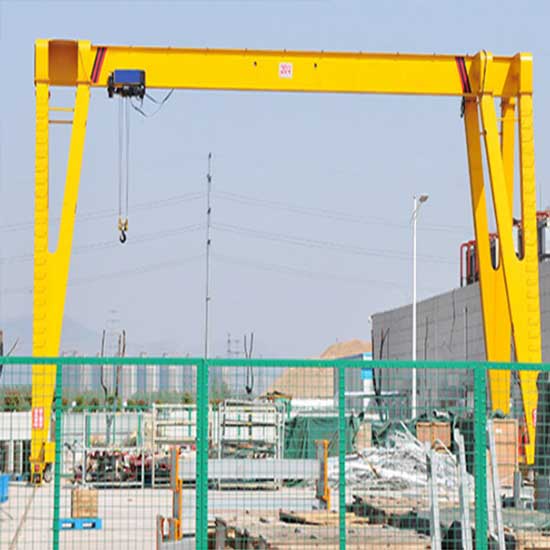
Light-duty gantry cranes are specially designed for handling lighter loads and are versatile enough for a variety of applications.
Applications in Indoor and Outdoor Setups:- Indoor Use: Commonly found in workshops, factories, and assembly lines, light-duty gantry cranes efficiently lift tools, materials, and components.
- Outdoor Use: These cranes are also effective in construction sites and outdoor environments, allowing for easy movement and operational flexibility.
- Adjustable Features: Many models offer adjustable height and width configurations, enabling users to tailor the crane to specific lifting tasks.
In conclusion, small gantry cranes—whether portable, mobile, or mini—offer flexible lifting solutions tailored to diverse operational needs. Their ability to enhance efficiency and adaptability makes them invaluable tools in various industries, enabling effective lifting in confined spaces and temporary job sites.
Small Jib Cranes for Sale : Maximizing Efficiency in Limited Spaces
Small jib cranes are specially designed to optimize lifting operations in environments with limited space. Their unique features allow for efficient movement and handling of loads in tight areas, making them ideal for various applications.
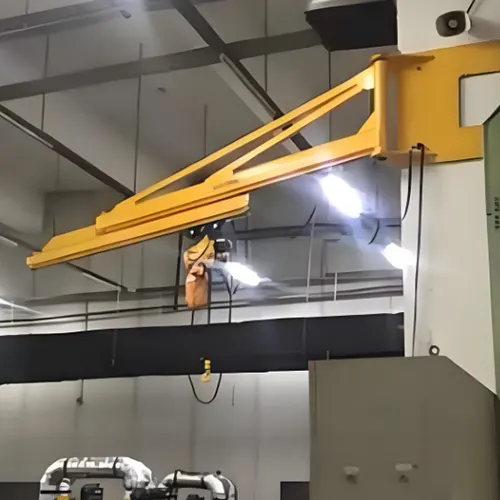
Wall-Mounted Small Jib Crane 500kg, 1 ton, 2 tons
Wall-mounted jib cranes are a practical solution for maximizing space efficiency in warehouses and workshops.
Ideal for Space-Constrained Environments:- Space-Saving Design: These cranes are affixed to walls, freeing up valuable floor space while providing effective lifting solutions.
- Enhanced Maneuverability: With a pivoting arm, wall-mounted jib cranes allow for easy movement of loads within a defined area, enabling operators to position materials precisely where needed.
- Applications: Frequently used in assembly lines, maintenance facilities, and small production areas, these cranes facilitate light to moderate lifting tasks without requiring extensive operational space.
Floor Mounted Small Pedestal Cranes 125kg, 250kg, 500kg, : Stability and Versatility
Small pedestal cranes offer robust lifting capabilities while maintaining a compact design.
Overview of Design and Applications:
- Sturdy Construction: Designed with a solid base for stability, small pedestal cranes can safely handle loads in various industrial settings, including workshops and repair shops.
- Versatile Usage: These cranes are suitable for a range of applications, from lifting machinery to assembling components in tight spaces.
Key Features Emphasizing Stability, Compactness, and Adaptability:
- Compact Footprint: Their small footprint allows for installation in limited spaces without compromising lifting capacity.
- Adjustable Heights: Many models come with adjustable lifting heights, enhancing their adaptability for different tasks.
- Wide Range of Applications: Ideal for maintenance, automotive repair, and light manufacturing, small pedestal cranes provide reliable performance in diverse scenarios.
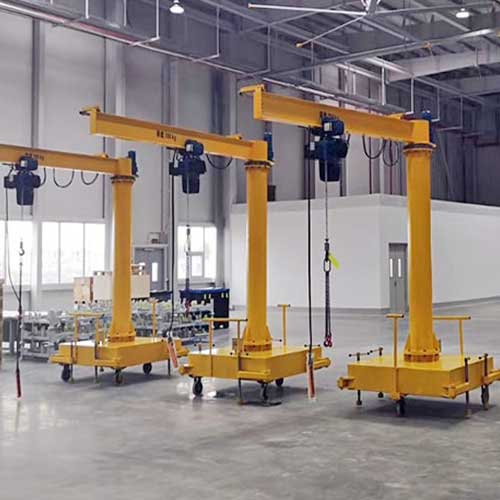
Small jib Crane Kits and Small Portable Jib Cranes for sale 500kg, 1ton, 2 ton
Jib crane kits and portable jib cranes offer customizable solutions for various lifting needs.
Customization Options and Ease of Installation:- Tailored Solutions: Many jib crane kits allow users to select components that meet specific requirements, such as arm length, height, and capacity, making them suitable for unique applications.
- Quick Assembly: Designed for ease of installation, these cranes can be quickly set up and dismantled, ensuring minimal downtime during operations.
- Portable Options: Some portable jib cranes can be moved easily between locations, providing flexibility in lifting tasks across different job sites.
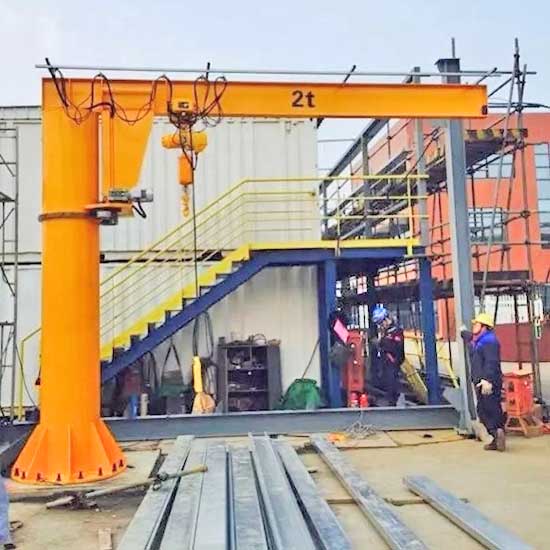
Light Duty Jib Crane 1 ton, 2ton, 3 ton, 5 Tons
Light-duty jib cranes are perfect for workshops and light industrial applications.
Why These Cranes Are Perfect for Workshops and Light Industrial Applications:- Designed for Lower Capacities: These cranes typically handle lighter loads, making them suitable for routine tasks such as lifting tools, materials, and small components.
- User-Friendly Operation: Equipped with simple manual or electric controls, light-duty jib cranes are easy to operate, allowing operators to quickly learn their use.
- Efficient Workflow: By enabling quick and precise lifting movements, these cranes enhance productivity in workshops and light manufacturing environments.
In summary, small jib cranes—whether wall-mounted, pedestal, or portable—offer efficient lifting solutions tailored to limited spaces. Their design features enhance stability, adaptability, and ease of use, making them indispensable tools in various industrial and commercial applications.
Small Overhead Cranes for Sale for Confined Spaces
Small overhead cranes are engineered to optimize lifting capabilities in confined spaces, making them essential for workshops, warehouses, and other tight environments. Their design enhances workspace efficiency while providing reliable lifting solutions.
Overhead Crane Systems
Overhead crane systems play a crucial role in maximizing workspace efficiency.
Benefits of Overhead Cranes:- Maximized Vertical Space: By operating above the ground, overhead cranes free up floor space, allowing for more efficient use of the workshop or warehouse area.
- Enhanced Lifting Capacity: These cranes can lift heavy loads without needing extensive floor space, making them ideal for various applications such as material handling, assembly, and maintenance.
- Improved Safety: Overhead cranes can reduce the risk of accidents associated with manual lifting, as they minimize the need for workers to handle heavy items directly.
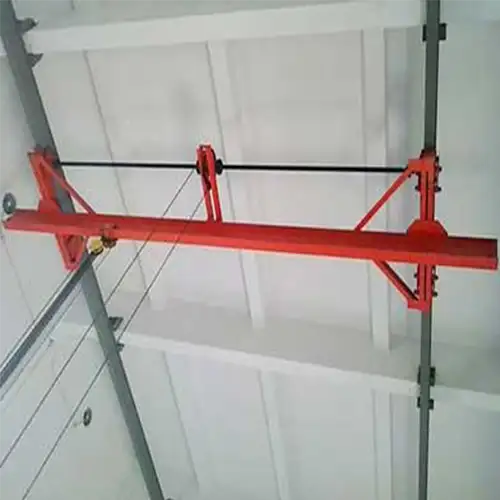
Mini Overhead Cranes and Low Headroom Solutions
Mini overhead cranes are specifically designed to address height limitations in various industrial settings.
Addressing Height Limitations:- Compact Design: Mini overhead cranes are designed with a low profile, allowing them to operate effectively in environments with restricted headroom.
- Adaptable to Various Settings: These cranes can be used in workshops, garages, and smaller manufacturing facilities, making them versatile tools for different applications.
- Improved Accessibility: Their compact structure enables operators to lift and transport materials in tight spaces, ensuring efficient workflow even in challenging environments.
Light-Duty Overhead and Bridge Cranes
Light-duty overhead and bridge cranes are ideal solutions for handling light loads within limited spaces.
Perfect for Light Loads:- Lifting Capacities: Designed to lift lighter loads, typically ranging from a few hundred kilograms to several tons, these cranes are perfect for everyday tasks such as lifting tools, components, or materials in smaller facilities.
- Ease of Operation: With user-friendly controls, light-duty cranes are easy to operate, ensuring that even less experienced personnel can safely and efficiently handle loads.
- Applications in Various Industries: These cranes find applications in light manufacturing, maintenance shops, and assembly areas, providing a reliable solution for low-capacity lifting needs.
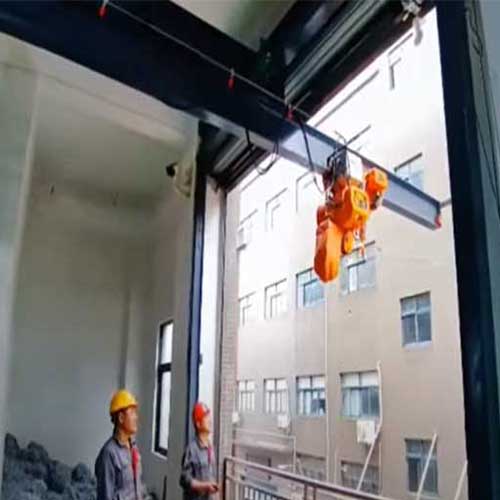
Small Telescopic Cranes 500kg, 1 ton, 2 ton: Versatile Reach and Height Options
Small telescopic cranes offer versatile reach and height options, making them suitable for various applications, particularly in maintenance and construction environments.
Ideal for Variable Reach and Height:- Adjustable Boom Length: The telescoping design allows operators to extend the crane's boom to reach elevated or distant loads, enhancing flexibility in lifting operations.
- Compact Size for Tight Spaces: Despite their reach capabilities, small telescopic cranes maintain a compact size, allowing them to operate effectively in confined areas where larger cranes cannot.
- Applications in Maintenance and Construction: Commonly used for tasks such as roof repairs, tree removal, and construction site lifting, these cranes provide the adaptability needed for diverse projects while ensuring safety and efficiency.
In summary, small overhead cranes and telescopic cranes are crucial tools for maximizing efficiency in confined spaces. Their unique features and designs cater to specific lifting needs, enhancing safety and productivity in various industrial and construction environments.
Hoists: Essential Lifting Tools for Small Crane Systems
Hoists are fundamental components of small crane systems, enhancing their lifting capabilities and providing flexibility for various applications. Understanding the different types of hoists and their functionalities is crucial for selecting the right equipment for specific lifting needs.
Industrial Hoists and Trolleys
Industrial hoists and trolleys work in conjunction with small cranes to streamline lifting operations.
Complementing Crane Systems:- Increased Lifting Capacity: Hoists can handle heavier loads than cranes alone, making them essential for operations that require lifting substantial weights.
- Versatile Configurations: When paired with trolleys, hoists can be mounted on overhead rails, allowing for horizontal movement of loads. This feature enhances efficiency when moving materials across work areas.
- Improved Workflow: The combination of cranes and hoists enables smoother workflow processes in manufacturing, assembly, and maintenance environments, reducing downtime and enhancing productivity.
Manual vs. Electric Hoists
Choosing between manual and electric hoists can significantly impact operational efficiency and ease of use.
Key Differences:
Power Source:- Manual Hoists: Operated by hand, requiring physical effort to lift loads. Ideal for lighter applications and where power access is limited.
- Electric Hoists: Powered by electricity, allowing for quicker and easier lifting of heavier loads with minimal manual effort.
- Manual Hoists: Typically slower and require more operator involvement, making them suitable for infrequent or light-duty tasks.
- Electric Hoists: Provide rapid lifting capabilities, increasing productivity, particularly in high-frequency or heavy-duty operations.
Advantages and Applications:
Manual Hoists:- Advantages: Cost-effective, easy to maintain, and portable. Suitable for low-capacity lifting tasks in workshops or maintenance areas.
- Applications: Ideal for tasks like moving small machinery, tools, or components in spaces where electric power is unavailable.
- Advantages: Greater lifting power and speed, reducing operator fatigue and increasing safety during heavy lifting operations.
- Applications: Commonly used in manufacturing, warehouses, and construction sites where efficiency and higher lifting capacities are essential.
In conclusion, hoists are vital lifting tools that enhance the functionality of small crane systems. Understanding the differences between manual and electric hoists, along with their respective advantages, helps businesses choose the right equipment for their specific lifting needs, ultimately improving operational efficiency and safety in various work environments.
Small Cranes for Specific Locations
Small cranes are designed to meet the unique demands of various environments, ensuring efficient lifting operations tailored to specific locations. Whether used indoors, on rooftops, or in outdoor settings, these cranes offer mobility, compact design, and adaptability for a wide range of applications.
Small Indoor Crane Systems
Small indoor crane systems are specifically designed for use in residential garages or small-scale industrial settings, where space and mobility are essential.
Mobility and Compact Design:- Space-Saving Solutions: These cranes can fit into tight spaces, making them ideal for areas with restricted dimensions.
- Flexible Operations: Their lightweight and compact designs enable easy relocation within workshops or garages, allowing users to adjust their setup based on ongoing projects.
Small Shop Cranes
Small shop cranes encompass various types, including overhead cranes, gantry cranes, hoists, and bridge cranes, all tailored for workshop operations with limited space.
Overview of Types:- Overhead Cranes: Ideal for lifting materials directly above workstations, freeing up floor space and improving workflow.
- Gantry Cranes: Offer versatility in lifting and moving materials, perfect for smaller operations where multiple tasks are performed.
- Hoists: Enhance lifting capabilities in compact areas, enabling operators to efficiently lift and position tools and equipment.
- Bridge Cranes: Provide a reliable lifting solution for workshop settings, ensuring maximum use of vertical space while maintaining ease of access to materials.
Small Roof Cranes
Small roof cranes are designed for applications in rooftop installations and areas with confined height restrictions, offering effective solutions for handling light to medium loads.
Applications in Rooftop Installations:- Versatile Lifting Options: These cranes can be used for HVAC installations, material handling for roofing projects, and other tasks requiring elevated access.
- Space Optimization: Their design allows them to operate efficiently in low-clearance areas while safely lifting and moving materials.
Small Yard Cranes
Small yard cranes are specifically designed for outdoor use and mobility, making them ideal for construction and yard-based operations.
Designed for Outdoor Use:- Durable Construction: Built to withstand outdoor conditions, these cranes are equipped with features that ensure stability and reliability on uneven ground.
- Mobility: Many small yard cranes are designed with wheels or tracks, allowing them to be easily moved across job sites as needed.
Portable Cranes for Temporary Job Sites
Portable cranes offer versatile solutions for projects that require mobility and adaptability, making them an excellent choice for temporary job sites.
Versatile Solutions:- Easy Setup and Breakdown: These cranes can be quickly assembled and disassembled, making them perfect for short-term projects or those that involve multiple locations.
- Adaptability: Designed to handle a variety of lifting tasks, portable cranes can be used for everything from construction to event setups, ensuring flexibility in their applications.
In summary, small cranes tailored for specific locations play a crucial role in enhancing operational efficiency. Their diverse designs and capabilities allow businesses to select the right equipment for their unique lifting needs, whether in indoor spaces, on rooftops, in yards, or at temporary job sites.
Key Considerations for Selecting Small Cranes
When selecting small cranes for various applications, it's essential for clients to consider several key factors. Each factor plays a significant role in ensuring the crane meets operational needs effectively and efficiently.
Size and Physical Dimensions
Compact or Small Size:
- Confined Spaces: Small cranes are crucial in areas where space is limited, such as workshops, garages, and narrow aisles. Their compact design allows for seamless operation in these environments.
- Installation Options: Consider wall-mounted or ceiling-mounted cranes that maximize floor space while still providing lifting capabilities.
Fitting into Specific Locations:
- Fixed Installations: Cranes that can be installed in specific spots are beneficial in locations like industrial plants or manufacturing facilities where workflow is essential. Wall-mounted jib cranes, for example, provide support without taking up valuable floor space.
Capacity and Lifting Requirements
Light Duty Applications:
- Affordability and Efficiency: Light-duty cranes typically handle loads ranging from a few hundred kilograms to several tons. This capacity makes them suitable for everyday tasks, such as moving materials and equipment in workshops.
- Operational Costs: Choosing lighter cranes can reduce operational costs, as they often require less power and can be more easily maintained.
Smaller Lifting Capacities:
- Specific Use Cases: Mini gantry cranes, small hoists, and overhead cranes designed for light loads are ideal for tasks like lifting tools or small machinery, thus improving workflow efficiency without overexerting the lifting capacity.
Mobility and Portability
Portable Solutions:
- Ease of Movement: Portable gantry cranes or mobile jib cranes allow for quick relocation between job sites. This mobility is particularly advantageous for projects that require frequent equipment repositioning.
- Storage Considerations: Cranes that can be disassembled or folded for storage make it easier to manage space when not in use.
Flexibility Across Work Sites:
- Outdoor Operations: Small yard cranes and mobile cranes are designed for versatile use in various outdoor environments, accommodating the shifting needs of construction or maintenance jobs.
Specific Locations and Site Requirements
Fitting into Specific Work Environments:
- Custom Solutions: Tailoring cranes for specific environments, such as small mechanical setups or workshops, ensures that they can perform optimally within the given constraints. Choosing cranes designed for the specific dimensions of the workspace is critical.
- Integration with Existing Equipment: Consider cranes that can seamlessly integrate with other machinery and equipment already in use at the site.
Low Headroom Areas:
- Height Limitations: Low headroom cranes are vital for spaces with restricted vertical clearance, such as basements or low-ceiling warehouses. Selecting cranes designed to operate effectively in these areas maximizes lifting capabilities without risking safety.
Ease of Use and Manual Operation
Manual or Simplified Cranes:- User-Friendly Operation: Clients may prefer cranes that are easy to operate, requiring minimal training. Manual cranes or smaller electric cranes are often simpler to use, making them ideal for businesses with varying operator skill levels.
- Control Mechanisms: Look for cranes with intuitive controls and clear instructions to enhance safety and productivity.
Light Duty vs. Heavy Duty
Lighter Tasks and Lower-Capacity Jobs:- Routine Applications: Light-duty cranes are designed for tasks such as assembling or lifting components in light manufacturing. They provide effective lifting solutions without the complexity of heavy-duty equipment.
- Reduced Wear and Tear: Choosing light-duty cranes helps in minimizing wear and tear on both the crane and the materials being lifted, leading to longer equipment life.
Specific Lifting Functions
Targeted Applications:- Customized Solutions: It's essential to find cranes that cater to specific lifting needs. For instance, mini engine cranes are ideal for automotive repairs, while small jib cranes work well for short-distance lifting tasks in tight spaces.
- Versatility in Functionality: Selecting cranes with interchangeable parts or attachments can enhance their usability across various applications.
Industrial or Specialized Cranes
For Industrial and Heavy-Duty Use:- Meeting Industrial Demands: Some clients may need small cranes that can perform effectively in industrial settings. Light-duty gantry cranes and small industrial cranes can handle specific tasks in light manufacturing or maintenance.
- Compliance and Safety Standards: Ensure that selected cranes comply with relevant industry safety standards and regulations to prevent workplace accidents and enhance operational safety.
In summary, understanding these key considerations will empower clients to select the right small crane for their specific operational needs, leading to improved efficiency, safety, and productivity in their work environments.
Conclusion: Making Informed Choices for Small Crane Selection
Selecting the right small crane is essential for maximizing efficiency and safety in various operational settings. Several key factors must be carefully considered to ensure that the chosen crane aligns with the specific needs of the business or project.
- Capacity: Understanding the lifting capacity required for specific tasks is critical. This involves assessing the weight of the loads to be lifted and selecting a crane that can handle these weights comfortably, without risking overload.
- Space: The physical dimensions of the crane and the workspace must be evaluated. Compact cranes are ideal for confined areas, while those with specific installation requirements (like wall-mounted models) can enhance space utilization effectively.
- Mobility: Portability is a significant factor for businesses that require flexibility across job sites. Portable cranes can be easily relocated and adapted to different work environments, making them ideal for temporary projects.
- Lifting Height: The required lifting height should align with the operational environment. Choosing cranes designed for low headroom areas or those with adjustable heights ensures that lifting tasks can be completed safely and efficiently.
